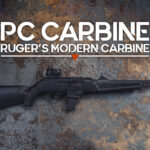
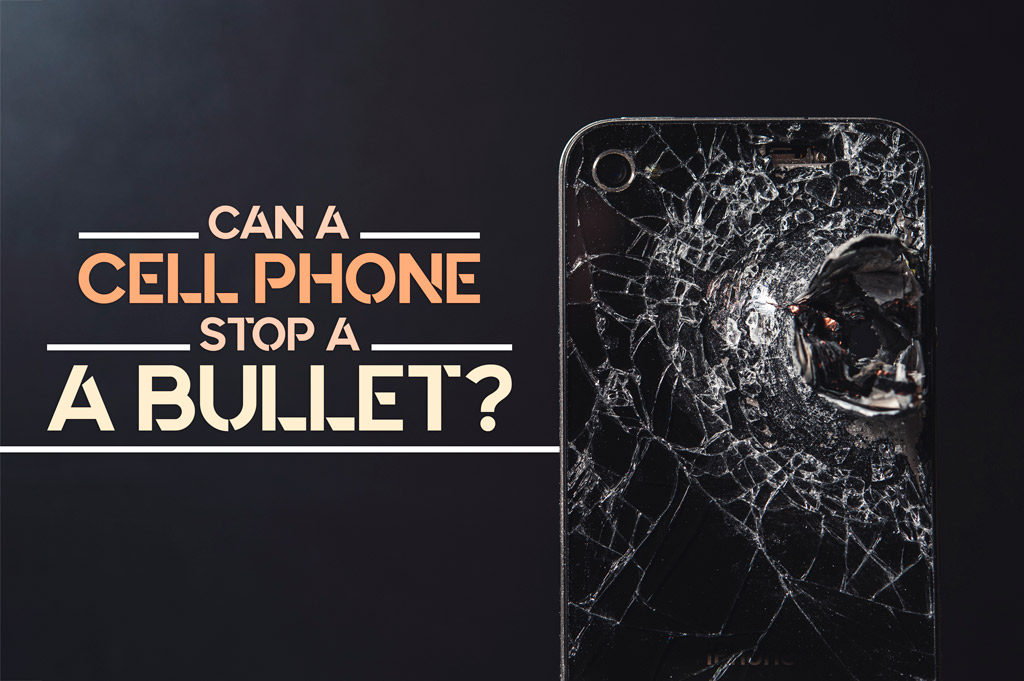
Guest Writer: Kenzie Fitzpatrick
There’s a brutal difference between fact and fiction. The things we see in the entertainment industry may look cool on screen but have no basis in reality. For example, in Hitchcock’s The 39 Steps, Richard Hannay’s (Robert Donat) life is saved when a hymnal in his pocket stops an assassin’s bullet. This popular trope has been used and reused many times over the years with a variety of objects all conveniently being able to stop a bullet.
Unfortunately, in the real world, we’ve all seen reports of shootings occurring in public locations. Many of which have been designated as “gun-free zones.” Fortunately for some, nearby objects and personal effects have prevented bullets from impacting their intended target. One of the personal items commonly reported on in these situations is the cell phone.
Will a cell phone stop a bullet? The team here at Widener’s decided to test this myth, take a look at what we discovered below.
Why A Cell Phone?

Almost everyone these days carries a cell phone in a pocket, a purse, or in a bag on their person.
Everyone you know has a cell phone, and most people carry them on their person. Looking at modern cell phones, they certainly seem capable of stopping a bullet, based on their size, weight, and construction. They come in a variety of sizes, and materials, including plastic, glass, and metal.
Before reading on, what are your hypotheses? Do you think common handgun calibers are capable of shooting through a cell phone? Or, do you think cell phones, like the iPhone or Android can stop a bullet? If these phones are penetrable, what kind of damage do you think will occur? Can’t decide? Take a look at our testing parameters below.
Testing Parameters
When we began researching the most common handgun calibers people carry, it became obvious what ammunition we had to use for the test. It should be no surprise that 9mm, .45 ACP, and .22LR topped the list. Even though .22LR is a rimfire cartridge, and is popular with rifle owners, there are quite a few semi-auto pistols, and revolvers chambered in it as well. Most handguns chambered in .22lr are compact in size, making them easy to conceal while carrying.
Ammunition Used In Our Testing:
| Caliber | Bullet Type | Bullet Weight | Velocity (Muzzle) | Energy (Muzzle) |
|---|---|---|---|---|
| .22LR | LRN | 40gr | 1,200 FPS | 128 FT LBS |
| 9mm | FMJ | 115gr | 1,180 FPS | 356 FT LBS |
| .45 ACP | FMJ | 230gr | 890 FPS | 404 FT LBS |
Cell Phones Used In Our Testing:
Another variable we decided to include in our test is comparing Android vs. iPhone. With the popularity of both cell phones, there was no way we could perform this test without pitting them against each other. Phone number one in our test is the iPhone 4. It has a thickness of 9.4 millimeters (0.37″). Phone number two is the Android Fire phone. It has a thickness of 8.9 millimeters (0.35″).
| Cell Phone | OS | Size | Weight | Features |
|---|---|---|---|---|
| iPhone 4 | IOS (Apple) | 4.5×2.3×0.37 | 4.8oz | Gorilla Glass/Stainless Frame |
| Fire Phone | Android | 5.4×2.6×0.35 | 5.4oz | Gorilla Glass/Aluminum Frame |
Why did we choose these two cell phones? The iPhone 4 is among the thickest iPhone models that Apple has produced to date. The Android Fire phone is only slightly thinner and has a reputation for being a tough phone to crack. Both phones feature hardened glass on the front/back, the iPhone 4 has a stainless steel casing, while the Android Fire phone features an aluminum casing covered in high-impact rubber.
You Big Dummy!
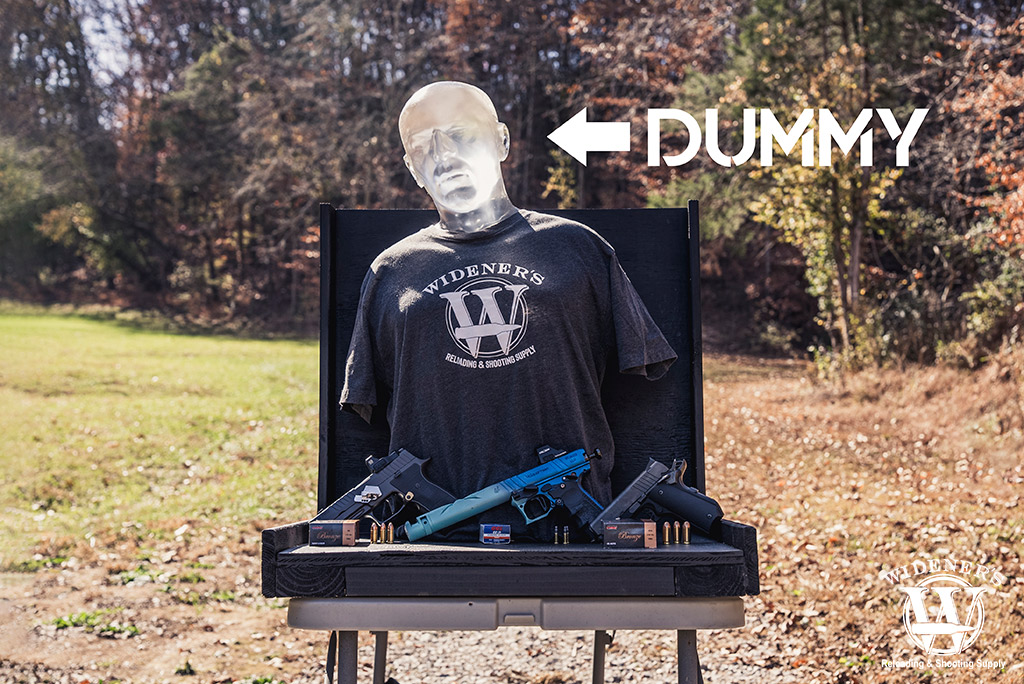
We placed the cell phones on the ballistic dummy and shot them from a distance of 45′ (15 yards).
To make the test as realistic as possible, we used a Ballistic Dummy Lab Torso to attach the cell phones to. We wanted to know, could a cell phone stop a bullet? If not, what would the impact would be on a human being after it penetrated the phone? I’ve personally shot through windshields, concealment barriers, tires, locks, and deadbolts and have collected data on what happens once the bullet makes an impact. Many times the bullet will deflect or take a non-linear path once it impacts something.
The average distance a shooting with a handgun takes place is somewhere around 6-10′ (2-3 yards). For safety reasons, we knew we didn’t want to shoot the cell phones any closer than 30′ (10 yards). After reviewing some data about drive-by shootings, and shootings in commercial buildings, we decided to shoot the cell phones from a distance of 45′ (15 yards). We did this using a bag rest on a bench, with each handgun fired at the same distance, with sights aimed at the front surface of the cell phones.
Cell Phone Stop A Bullet? A Hypothesis
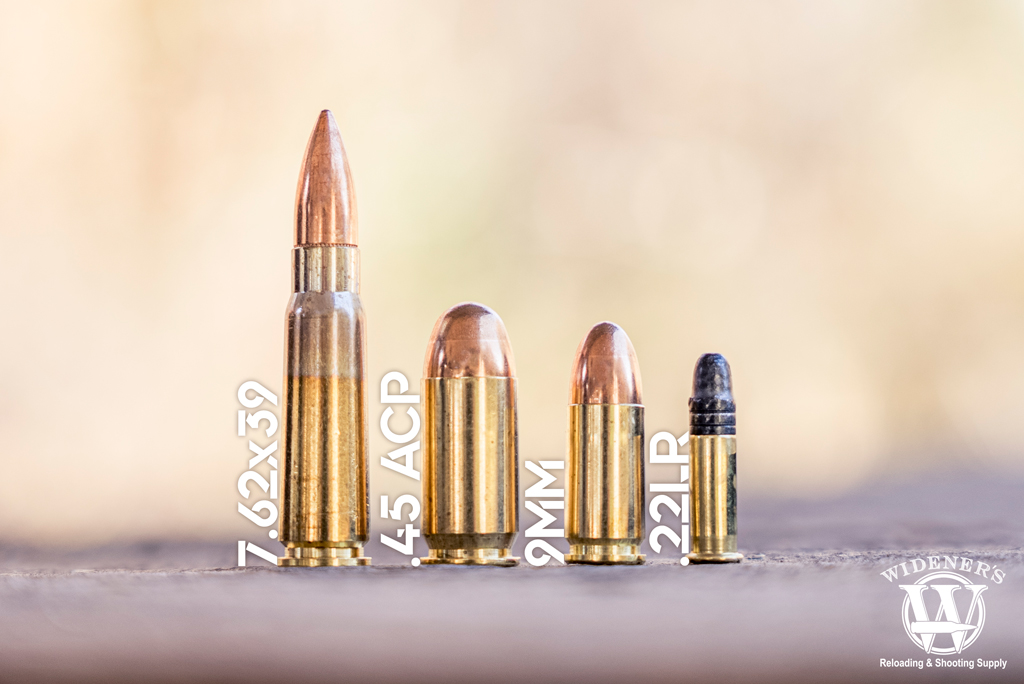
Ammunition used in our testing, from left to right: 7.62x39mm, .45 ACP, 9x19mm, and .22LR.
To understand my hypothesis, you’ll need to understand my background. I’ve had my concealed carry gun permit since legal age, and I’ve carried a gun almost every day of my life. Shortly after I got my permit, I began taking instructor courses to teach handgun classes and eventually began instructing. I’ve been instructing new permit holders and teaching handgun classes for a decade.
During this time, not once, have I carried, or recommended anyone else carry a .22LR pistol for self-defense. The stopping power is not enough to be a good self-defensive round. On top of that, rimfire ammo isn’t the most consistent, it’s more prone to jam or cause malfunctions. Now that’s out of the way, let’s move on to the important stuff.
Caliber Performance
My hypothesis is that the .22LR will penetrate the phone, causing at least surface-level damage. The damage will be from fragments moving outward rather than from deeply penetrating the Ballistic Dummy Lab torso. With such a small projectile, I don’t expect the .22LR to have any real stopping power (on a human being) once it impacts the cell phones. With not much difference between the thickness of an Android and iPhone, I don’t expect either phone to be operable after being shot with a .22LR.
As someone who’s shot thousands of 9mm rounds in the last decade, a hypothesis of what will happen to the phones is easy to make. I assume the 9mm will make easy work of both cell phones and penetrate through both. I’ve seen 9mm do some crazy things once impacting a barrier. I believe a full metal jacket will pass through the phone, potentially entering the dummy torso, but I estimate the impact will slow it down significantly.
When it comes to 45 ACP, there’s really no betting against this caliber to fail. After all, it helped win two World Wars, and the stopping power of a 45 ACP just can’t be beaten. This caliber will make quick work of the cell phones and cause some damage to the Ballistic Dummy Lab torso. Because it’s a full metal jacket, I assume it will penetrate through the phones and continue on through our dummy. Because the muzzle velocity of 45 ACP is much slower than the 9mm, even though the sizes are much different, I expect it will perform similarly.
Data Collection
When it comes to data collection and testing, we wanted to cover our bases. First was whether or not a cell phone would stop a bullet. Second was the rate of failure for both the iPhone and Android and to see if either one was better than the other. The Third was to see how far the bullet penetrated the phone, and how far into the Ballistic Dummy Lab torso the bullet or fragments would go.
We recorded all of the test shots using a high-speed camera to see the maximum damage to the phones and torso. We also recorded the shots with high-resolution cameras so we could compare the playback and results. After each shot, we went downrange to inspect our cell phones and took measurements, to determine the effects on the ballistic torso. Doing this allowed us to capture the data to make it comparable for each caliber and phone.
Will A Cell Phone Stop A Bullet?
Will a cell phone stop a bullet? What do you think? Take a look at our video in the link below to see if this popular myth is real, or busted:
Handgun Ballistics
22LR VS iPhone + Android
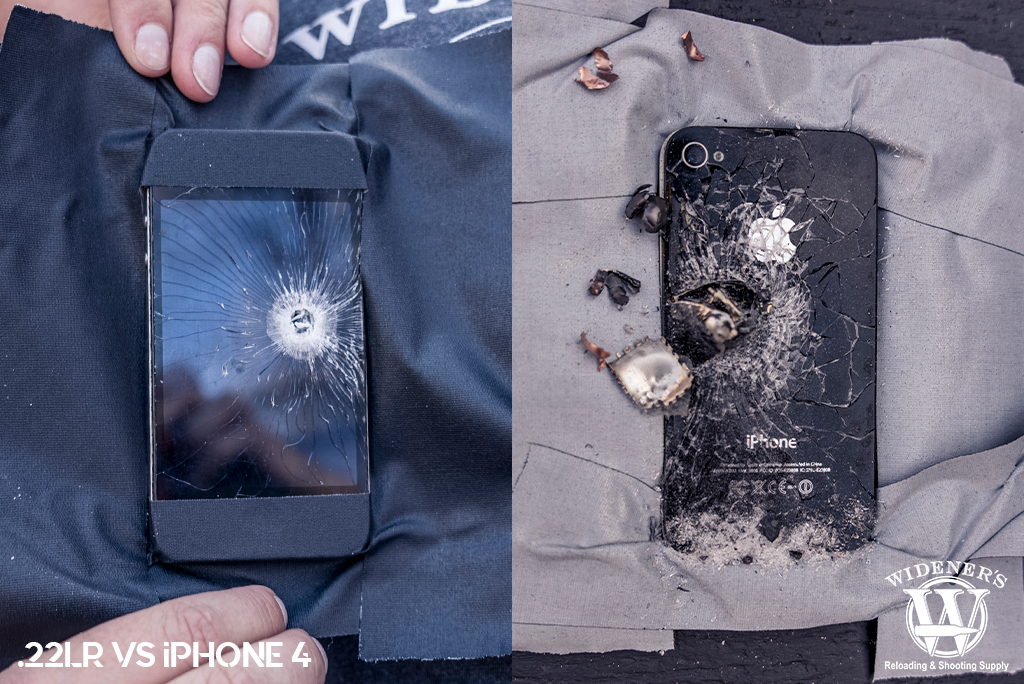
The .22LR bullet penetrated the iPhone 4, but fragmented on its way into the ballistic dummy.
For the .22LR testing, I got to use one of my favorite guns, the Volquartsen Mamba-X, 6” with the HS407C X2 optic. With a zero of 15 yards, it was sighted in and ready to shoot. The .22LR performed pretty much as I predicted. It penetrated both the Android and iPhone, without causing too much damage to the Ballistic Dummy Lab torso. The 40gr lead round nose bullet fragmented after going through the iPhone (between 2-6″ of penetration). Other than a few splinters traveling upward, didn’t have a clear path through the dummy torso. In comparison, bullet fragments passed through the Android phone and lodged about 4″ deep in the chest area.

Don’t put your faith in technology. The .22LR bullet penetrated the Fire Phone and lodged 4″ in the dummy torso.
When the phones were turned around, only a few bullet fragments were stuck on the exit from the phones. Although both phones slowed down the bullets, and caused them to fragment, neither completely stopped the fragments from penetrating the chest of the dummy. I think this is more of a testament as to why .22LR shouldn’t be used for self-defense. But that’s not why we’re here. In terms of whether or not a cell phone stops a bullet from a .22LR caliber pistol, I’m going to say that myth is busted. Having a clear entry and an impressive exit through both phones shows that they aren’t robust enough to stop even the smallest of our test calibers.
| Caliber | Gun/Barrel | Target Distance | iPhone 4 | Depth | Fire Phone | Depth |
|---|---|---|---|---|---|---|
| .22LR | Volquartsen Mamba/6″ | 15-Yards (45′) | Fragmented Penetration | 2-6″ | Penetration | 4″ |
9mm VS iPhone + Android

The 9mm bullet barely even slowed down when passing through the iPhone 4 in our testing.
I used the all-new Sig P320-AXG Legion topped off with an EOTECH EFLX mini red dot sight for the 9mm testing and also zeroed it at 15 yards. Spoiler alert, if you’ve been paying attention, you already know the outcome. The 115-grain full metal jacket ammunition easily penetrated through both the Android and iPhone phones. The 9mm also penetrated through the Ballistic Dummy Lab torso to cause some pretty decent-sized cavity wounds that I think would be catastrophic or at least, severely damaging to a human.

Things got interesting with the Fire Phone, the bullet stayed intact after passing through and into the dummy’s torso.
The 9mm bullet that passed through the iPhone partially fragmented and spread into different wound channels (about 6″ penetration). The larger piece of the bullet that stayed intact passed through the dummy, and into the backstop (10″+ penetration). On the Android phone, the 9mm bullet passed through but slowed down enough in the ballistic torso to bounce off of the backstop and land next to the dummy (10″+ penetration). The jacket was slightly damaged, a few fragments were missing, but for the most part, the bullet was intact.
I’m calling 100% myth busted on whether a cell phone will stop a 9mm bullet. These phones have little to no ability to defend you against a 9mm.
| Caliber | Gun/Barrel | Target Distance | iPhone 4 | Penetration | Fire Phone | Penetration |
|---|---|---|---|---|---|---|
| 9mm | Sig P320/3.9″ | 15-Yards (45′) | Fragmented Penetration | 6-10″+ | Penetration | 10″+ |
45 ACP VS iPhone + Android

Two World Wars: The .45 ACP ain’t got time for Apple’s Silicon Valley nonsense.
For the third and final test, I used an old-school Para Ordnance .45 ACP handgun with iron sights. As before, I knew that neither phone would be a match for stopping the .45 ACP caliber. With the iPhone, the wood behind our Ballistic Dummy Lab torso blew out the back. I knew it was over from there. The bullet traveled upward before going through the backstop, easily giving us 10″+ of penetration depth. The mass of the .45 ACP was just too much for the Silicon Valley wunderkind.

Catastrophic damage on display to the Andriod phone by the .45 ACP FMJ bullet.
The Android Fire Phone didn’t fair any better. There was a giant entry and massive exit on the Android, and our poor dummy was no match for surviving this strong caliber. Again, the wood on the backstop blew out the back with the bullet, giving us 10″+ of penetration depth. So no, a cell phone won’t stop a bullet from a .45 ACP handgun. No chance. Myth busted. Game over.
| Caliber | Gun/Barrel | Target Distance | iPhone 4 | Penetration | Fire Phone | Penetration |
|---|---|---|---|---|---|---|
| .45 ACP | Para Ordnance/3″ | 15-Yards (45′) | Penetration | 10″+ | Penetration | 10″+ |
Soldier Saved By A Cell Phone?
During the Russian VS Ukranian conflict, a story emerged from news sources about a Ukranian soldier who claimed his life was saved after his cell phone stopped a 7.62mm bullet, allegedly fired at him by Russian troops. This story happened not once, but…twice, to two different Ukranian soldiers. If you haven’t seen these videos, take a moment to watch them for yourself in the links above and draw your own conclusions.
In the first video it appears that the 7.62mm bullet struck the front of the phone from an angle, partially passing through it, and lodging in the protective case. It’s unclear how the soldier was carrying the phone when it was struck, but he’s shown wearing a plate carrier. In the second video, it looks like the bullet struck the phone on a plate carrier, center mass on the back of the phone case. It’s unknown the exact bullet that was fired, or from what barrel length, or distance. But Jacob from Widener’s is going to attempt to recreate a similar scenario for this test on the range.
Rifle Ballistics
Although the reports seem to indicate that a 7.62mm bullet struck the soldier’s phones, it is more likely that the bullet in question is 5.45x39mm. The current Russian standard service rifle is the AK-12, chambered in 5.45x39mm. That’s not to say Russian troops don’t have rifles chambered in 7.62mm. It’s just more likely that Russian Ground Forces would be carrying rifles chambered in 5.45x39mm on the battlefield in Ukraine. In fact, there’s pretty solid evidence that both Ukrainian and Russian forces are carrying AKM-style rifles into combat. How do these two calibers match up? Take a look at the chart below:
| Caliber | Bullet Type | Bullet Weight | Velocity (Muzzle) | Energy (Muzzle) | 100 Yards (Velocity/Energy) | 200 Yards (Velocity/Energy) | 300 Yards (Velocity/Energy) |
|---|---|---|---|---|---|---|---|
| 7.62×39 | FMJ | 124gr | 2,350 FPS | 1,520 FT LBS | 2,078 FPS/1,189 FT LBS | 1,824 FPS/916 FT LBS | 1,595 FPS/701 FT LBS |
| 5.45×39 | FMJ | 60gr | 2,622 FPS | 1,060 FT LBS | 2,332 FPS/724 FT LBS | 2,002 FPS/534 FT LBS | 1,722 FPS/395 FT LBS |
Testing Parameters
For the sake of argument, Jacob will be using a 123gr FMJ 7.62x39mm bullet for the test. Although the 5.45x39mm has a higher velocity, it is also more prone to tumble when striking a barrier. The 7.62x39mm bullet is larger and has more energy, which translates to more stopping power and should give us a good idea of how much damage a cell phone can endure. To perform the test, Jacob will fire the 7.62x39mm bullet from an AK-47 style rifle, with a 16″ barrel from a distance of 100 yards from the ballistic dummy torso. As before, data is collected after each shot to record the failure rate of the cell phones, and the damage inflicted to the ballistic dummy torso.
Ammunition Used In Our Testing:
| Caliber | Bullet Type | Bullet Weight | Velocity (Muzzle) | Energy (Muzzle) |
|---|---|---|---|---|
| 7.62×39 | FMJ | 123gr | 2,350 FPS | 1,495 FT LBS |
7.62×39 VS iPhone + Android
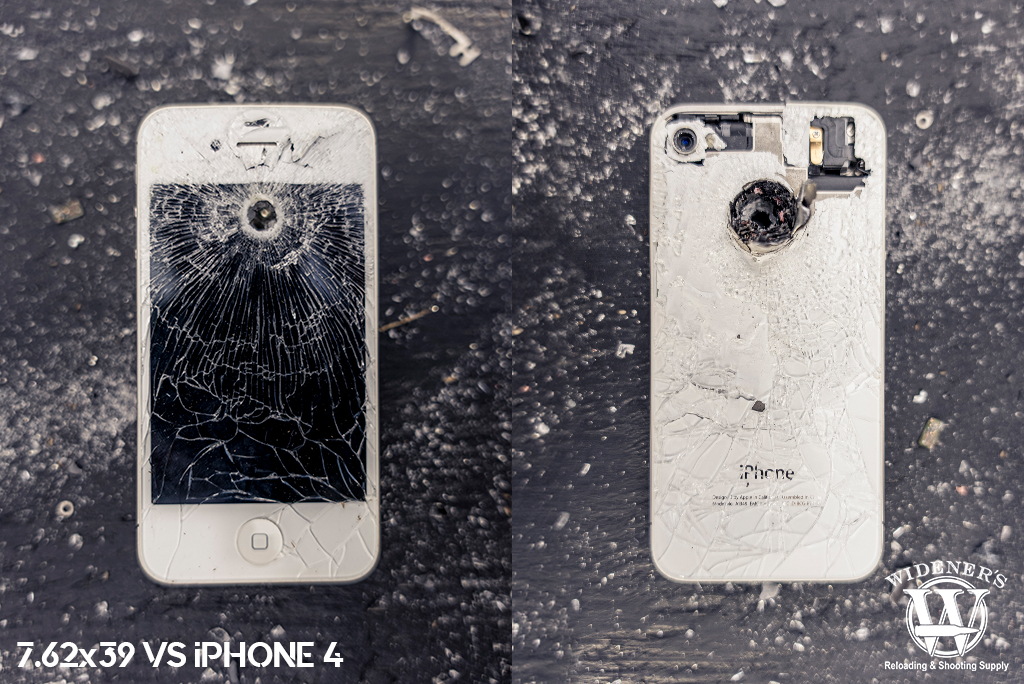
The legendary iPhone 4 was no match for a 7.62×39 bullet fired from an AK-47.
For the iPhone 4 test, Jacob used an AK-47 with a 16″ barrel and a basic 1x red dot sight on a side mount rail. The red dot optic was zeroed for belt-buckle height at 50 yards. From a distance of 100 yards, it seemed possible that the phone might at least slow the .30 caliber bullet down. However, that was not the case. The 7.62×39 FMJ bullet zipped right through both phones and the wooden backstop. The 123gr bullet went through the iPhone 4 like a hot knife through butter. It left a very clean entry, and exit wound through the chest of the ballistic dummy (10″+ penetration).

The 7.62×39 FMJ bullet zipped right through the Android Fire Phone.
The Android Fire Phone ignited for a split second as the 7.62×39 FMJ bullet zipped through it. My guess is that the battery discharged. Either way, if the phone slowed the bullet down, we couldn’t find any evidence to prove so. Rifle ballistics are a different ballgame compared to handguns. The 123gr bullet went through the phone, ballistic dummy, and backstop without breaking a sweat, giving us 10″+ of penetration depth. I’ll say this, don’t depend on electronic devices to stop rifle-caliber bullets in an emergency situation. Myth totally busted.
| Caliber | Gun/Barrel | Target Distance | iPhone 4 | Penetration | Fire Phone | Penetration |
|---|---|---|---|---|---|---|
| 7.62×39 | AK-47/16″ | 100-Yards (300′) | Penetration | 10″+ | Penetration | 10″+ |
What’s Actually Going on?
So what’s actually going on? In the stories we see in the news, it sounds like cell phones are one step away from being body armor. How is it possible that some cell phones stop bullets…while others don’t? Two different possibilities are happening in these civilian scenarios.
One is that the bullets are striking surfaces, or passing through barriers before making contact with the cell phones. There’s very little detail in most of the news reports about this information. The bullets in question may be passing through a window, a plexi-glass divider, a store display, or a combination of objects before being stopped by the phone. From our testing, it is evident that bullets striking barriers do slow down and often fragment before expending their energy.
The second possibility is that the bullets are small caliber, and are being fired from short barrel or snub nose handguns. To give you an idea, a 4ogr .22LR LRN bullet (like the one in our test data) has a muzzle velocity of about 800 FPS when fired from a 2″ barrel revolver. At a distance of 45′ (15 yards) that same bullet drops considerably in velocity, and energy. A .22LR bullet could still be deadly at that speed, but it’s also a lot easier to stop or deflect it once it makes contact with an object. It’s not a stretch to assume that one, or both of these possibilities are responsible for the stories that we read about in the news.
Battlefield Considerations
In the videos from the Russian VS Ukrainian conflict, it’s evident that both soldiers are wearing plate carriers. Although we don’t know what level of body armor they are carrying, we do know, based on the videos, that it’s possible their phones were carried in front of the plates. Applying that knowledge to the data we collected, it seems more likely that the body armor they had on under the phones, actually stopped the bullets from penetrating, rather than the phones themselves. One video shows the intact bullet still lodged in the phone, while the other seems to have fragmented and been stopped after passing through.
There is a slim possibility that the soldiers had a bullet proof phone case. However, given the cost, it’s pretty unlikely. A more realistic scenario is that the bullets allegedly fired at them came from a considerable distance. At 300 yards, a 123gr 7.62×39 FMJ bullet (like the one in our test data) has a muzzle velocity of 1,583 FPS, and an energy of 684 FT LBS. At 500 yards, the same bullet drops to 1,171 FPS, with 374 FT LBS of energy. Although the bullet is still deadly from those distances, it’s also traveling at about half the speed (and energy) it had when it left the rifle’s barrel. A cell phone may not stop it, but modern body armor certainly will.
Can A Cell Phone Stop A Bullet: Fact VS Fiction
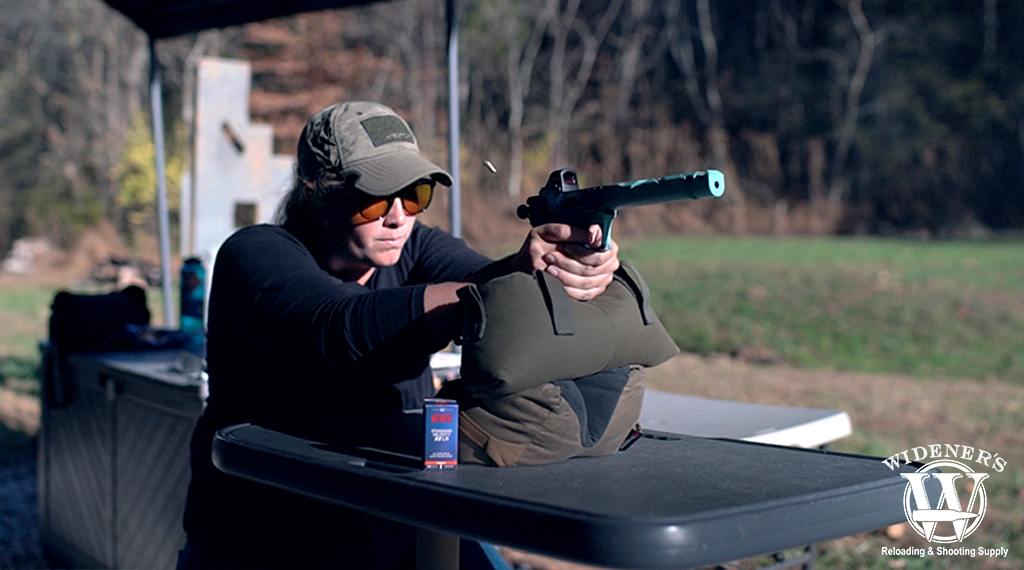
Can a cell phone stop a bullet? Don’t bet your life on it.
No one likes to think about the possibility of getting shot. Statistically, the odds are extremely low. However, That doesn’t mean they are zero. If anything, this myth-busting project has convinced me to invest in body armor, instead of trusting in everyday carry pocket or purse items for protection. At 15 yards, the power of even a .22LR caliber can penetrate a solid object like a cell phone. Anything beyond a 9mm sized caliber is definitely going to penetrate a cell phone and likely continue on through you.
A phone is a small target and depending on the location you carry it, it isn’t going to cover any vital organs that need protecting. Body armor these days doesn’t have to be military-style Level 4 plates in a tactical carrier. I use a bulletproof laptop case and Level IIIA backpack insert from Premier Body Armor. It’s easy to travel with, protects my vital organs, and can be used as a shield if needed. Hollywood definitely got this one wrong, as they often do. The bottom line? Don’t rely on a cell phone to stop a bullet.


